Lewin Benjamin (ed.) Genes IX
Подождите немного. Документ загружается.

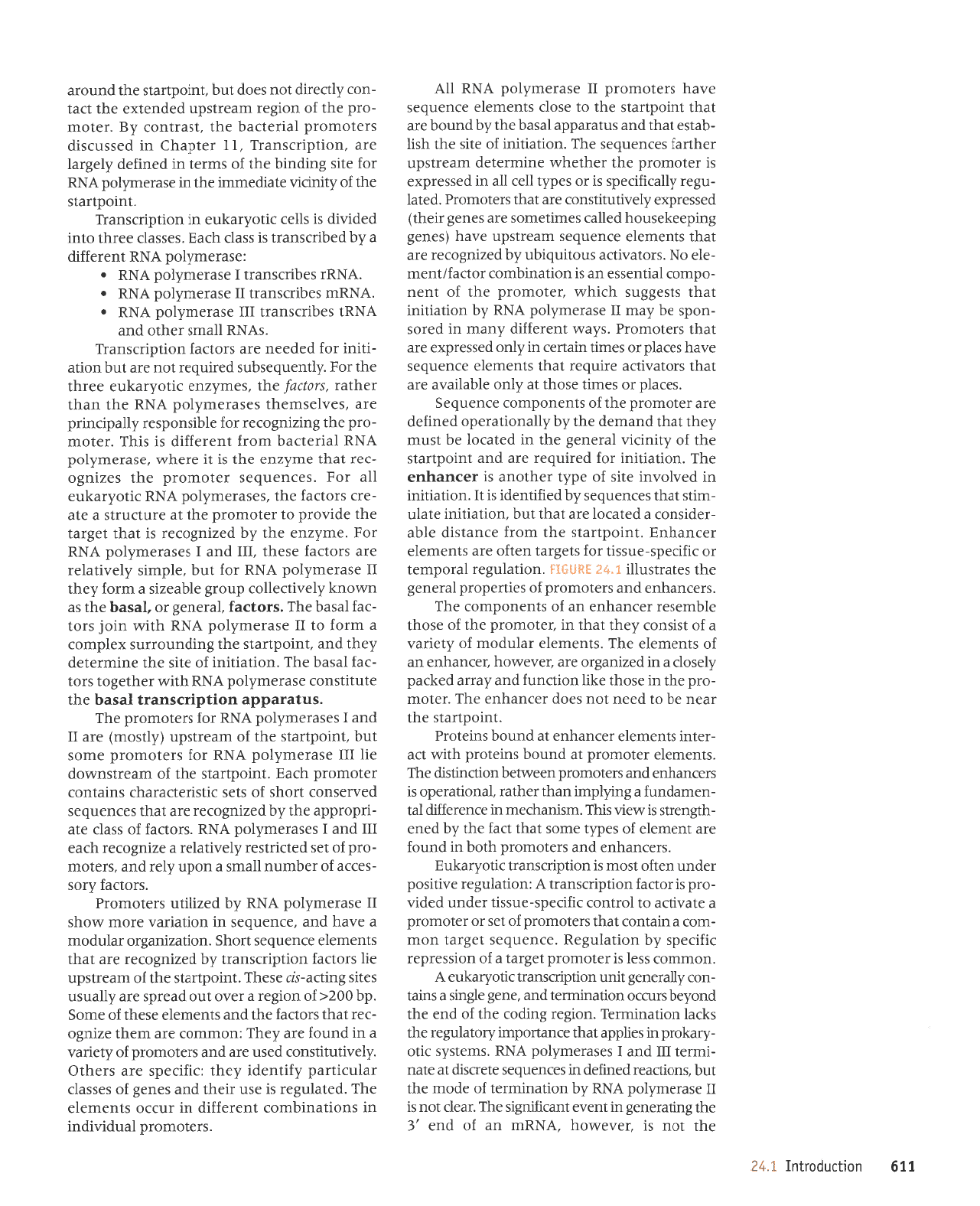
ll9
uor]lnporlul
I'tz
eql
lou
sr
'rJ^aMoq 'YNuru
ue
Jo
puJ
,€
eql Srntpraue8
ur
tuarra
luBrgru8rs
er{J
'rpep
tou
sr
11
ase:au.dyod
VNU
Iq uoqeuruuat
Jo
apou Jql
lnq
'suorpeJJ
perrr.JJp
rn sJJuanbas JIJTJSIp
lp
Jleu
-IurJat
III
pup
1
saseraru^d1od
VNU
'srualsr(s
rrlo
-fuu1ordrn
saldde
1eq1
arupuodu4 fuoteln8ar aql
s>pel
uoueunural
'uor8ar
Supor Jqt
Jo
pue
aql
puo,{.aq
srrnro uorleururar
pue
'aua3
aprns
e srnel
-uor
.{leraua8
lrun
uoudutsuerl rqofuelna
y
'uoruruoJ
ssJI sr JJlotuord
la8rBt
e
;o
uorssa;d:r
rr;nads
.{q uorleln8ag
'atuanbas
1a3:Bl
uoru
-ruoJ
e urpluoJ
leql
sraloruord;o
las
.ro raloruo.rd
p
elenrDe 01
IoJluoJ
rrlr:ds-anssu rJpun
peph
-ord
sr roDe;
uorldrrlsue,rl
V
:uouelnBar a.r,rlrsod
rJpun
uJUo
lsour
sr uorldrrtsue.rl :rto,{.le1nJ
'srJJuequa
pup
sJatouord
qroq
ur
punoJ
Jre
tueruale
yo
saddl
auros
leql
ppJ
eqt
Lq
paua
-qfuaJ$
sr rvrarl
snrJ
'rusrueqJJru
rn JJueJalJIp
Iel
-ueuepunJ
e 8ur.d1dun
ueqt JJqlEJ
'leuonerado
sr
sJaJuer{ua
pup
sraloruo:d uaJMlJq uorDulslp JqJ
'sluJrualJ
raloruord
tp
punoq
suralord
qllM
lJp
-Jelu
slueurela Jaf,upque
1€
punoq
suraloJd
'luroouels
Jql
JeJu
Jq 01
peeu
lou
sJop JJJupqua JqJ
'Jalou
-ord
aq1 ur esoqt
e>lrT uorpun;
pue,{e:re
palred
,{1asop
e ur
pazrue8ro
aJe taAJMoq tJJupqua ue
Jo
stuauale
aqI
'sluJruala
rplnporu
;o
l.1aue,L
p
Jo
lslsuo)
Laql
leqr
ur ?aloruo:d aql
Jo
esoql
elquesJr Ja)uequa
ue
Jo
sluJuodruor aql
'sref,upqua
pue
sraloruord;o
saruadord
praua8
aql sJterlsnlll
t'te
*ufi*ig
'uoqeln8ar
lerodrual
ro rr;nads-anssrl
JoJ sla8rel uJUo Jle sluJruale
Jelupquf
'lurodlrets
aql
uorJ a)uptsrp
elqp
-Japrsuo)
e
pJle)ol
arE
leql
lnq
'uorlPrlFr
aleln
-urts
tpqt
satuanbas [q
palJpuapl
sr
tI
'uopeplul
uI
pellolur
alls
Jo
ad,{.1 raqloue sr Je)ueque
aqJ
'uollelllur
roJ
palnbar
eJp
pup
turoduets
Jql
]o
.{]runrl
leraua8
Jql ur
pJlpJol
Jq
lsnru
z(aql
teql
pueuJp
aqr
r(q.{leuollerado
prurlap
ale JaloruoJd
aql
yo
sluauodruor aruanba5
'sareld
Jo serurl
asoqt
tp
,{1uo
alqepene
are
lpql
srole^rlre
arrnba:
lpql
sluJruJla aruanbas
a^r,eq
sareld ro serurl upuar
ur
,{1uo
passerdxa
are
leql
sJJloruor4
's,{ezr,r
luJJJJJrp
,{.ueru ur
paros
-uods
aq.{eru
1
aseraru.dlod
yNU
^q
uortprlrul
leqt
slsaSSns
qJrqM
'ratoruord
Jql
Jo
tuJu
-odruor
IepuJssa
ue sr uorl€urqruoJ JoDeJ/luau
-JIa
oN
'srotelrpp
snolrnbrqn ,{q
panuSorar are
teqt
slueuala aruanbas ruearlsdn aneq
(sauaE
Sutdaalasnoq
pJIIeJ
serurteuros are saua8 rtaqt)
passardxa
Llalrlntusuo)
eJp
tpql
sratoruoJd'palpl
-n8ar
Llerr;nads
sr ro sad,h
IIaJ IIe
ur
passardxa
sr
ratoruord
aql JaqlJqM JurruJetJp rrrpeJtsdn
JaqupJ saluanbas
aql
'uopeplur
Jo
Jtrs
eql
qsll
-qplsr
]eqt
pue
snlerBdde
leseq
aqr.{q
punoq
aJp
lPql luroduels
Jqt
ol JSop sluaruJla
aruanbas
aneq sralouord
1
aseraur,{1od
VNU
IIV
's:aloruord
IPnpr^rpur
ur suorleurqruoJ
luaJaJJIp
uI JnJJO SlUeluJIe
aq1
'pareln8ar
sr
Jsn Jraql
pup
sauaS;o sassplJ
rBlnttued
dllfuapt ,{aqt
:lr;IJads ere srJqlO
'.{lanrlnlusuo)
pesn
aJp
pup
sreloruord;o ,hatren
p
ut
punoJ
are
daql
:uoruluoJ
arp ureql aztuSo
-)Jr
leq]
sropel
aql
puP
sluauala
JsJql
Jo
euros
'dq
0Oz<
Jo
uor8ar e
JJAo
1no
peards
are z{1ensn
salrs Surtre-sr
asJqJ'luloduels
aql
yo
ruearlsdn
er1 sJolJpJ uollduJsuerl
ziq
pazuSo)ar
aJe
lpql
slueuale
aruanbas
uoqs
'uoupzruBS;o
JBInpou
e
eAPq
pue
'aruanbes
uI UOIIPIJP^ eJolu
Moqs
1
aserarudlod
VNU
,{.q
pazlgln
srJloruord,
'srolf,eJ
Aros
-sJ)Je
Jo
Jaqrunu
ilprus
e uodn,{1ar
pue
'sJaloru
-ord;o
tes
petJrJlseJ,{1arrr1e1a.r e azruSorar
qrea
11I
pue
1
saserarudlod
VNU
'sJoDpJ
Jo
ssplJ ete
-rrdordde
aql ,{.q
pazruSorar
are
lBql
saruanbas
paAJJSUOf,
UOqS
JO
S1JS JIISIJaI)PJeqJ SUIPIUOJ
,raloruord
qreg
'luroduets
Jq1
Jo
lrreaJlsuMop
arl
11I
aseJJruIlod
VNU
JoJ sr:loruord aruos
1nq'lurodlrets
eqt
Jo
ruBansdn
(dpsoru)
are
1
pup
I
sasereru,{1od
y51g
roy s.raloruord aql
'snlB,reddB
uolldlnsuprl
IEsEq
JI{l
elnlrtsuoJ
aserarur(1od
vNu
qtl^
raqle8ol srol
-JeJ
Ipspq
er{J
'uouellrur
Jo
elrs eql aulrrJelap
,(aqt
pue
'luroduels
aql Surpunonns
xaldruot
p
ruroJ ol
II
aserJruu(1od
y515
qlpzr
utol srol
-)eJ
Iespq
aqJ'sJopeJ
'praua8
Jo'Iespq eqt se
uMou>l
LlazrrDallor dnor8 elqeezls
e ruro;,{aql
I
aseraruzl1od
VNU
ro;
lnq
'aldrurs
z(lanrtelar
ere sro]f,eJ
esaql
'III
puP
J
sJseJJru.dlod
yldg
rog
'arur(zua
aqf
,{q
pazruSora:
sI
leql
la8rel
aql aprrrord o1
ralourord aql
le
JrnlJnJls P ele
-aJ)
srolJeJ
aql
'saserJruz(1od
y55
lpo'fue1na
IIe
Jod
'saruanbas
ralourord
aql sazluSo
-JeJ
leql
aurz(zua
aql sl
1I
eJeqM
'aseraruz(1od
vNu
IerJal)eq
IUOJI
luarJJJIp
sl slqJ
'Jelour
-ord
aql SurzruSorar
ro; alqrsuodsar
zlledrturrd
arp
'sJ^IJsruaql
sJseJeruz(1od
y5g
eq1 upql
JaqlpJ
'stopal
aql
'saru,{.zua
rtlou(re1na
earql
aql Jod
'f,ltuanbasqns
parmbar
1ou
eJP
lnq
uollP
-IUur
JoJ
pepeeu
alp
sJolJpJ uoltdtnsue4
'svNu
IIPurs
reqlo
pue
VNU1
seqrrlsuerl
III
aseraurLlod
VNH
.
'VNUru
seqrJf,suprl
1
aserarudlod
VNU
.
'VNUI
sJqlJf,sueJt
1
aseraruz{1od
VNE
.
:aseraurr{1od
vNu
luereJJrp
e,{q
paqrnsupJt
sr
sselJ
qJeg
'sasspll
JeJql olul
pJpl^lp
sr s[[J) :rlor{.re4na
u1 uotldprsue4l
'luroouels
aq1
;o
,hllnrr^ Jlelpaurufi
aql ut aseraur,{1od
YNU
JoJ
alrs Surpurq
aql
Jo
slurJt
uI
paulJap
,{1a8re1
are
'uorldrrJSueJJ
'11
rardeq3
uI
pJssnJSIp
sralourord
IeIJalreq
Jql
'lsprluor
,{g
'raloru
-ord
aq1
yo
uor3ar
ruBarlsdn
papuexa
eqt
ppl
-uor.d1lrar1p
lou
saop
1nq
'tuloduets
JI{l
punoJe
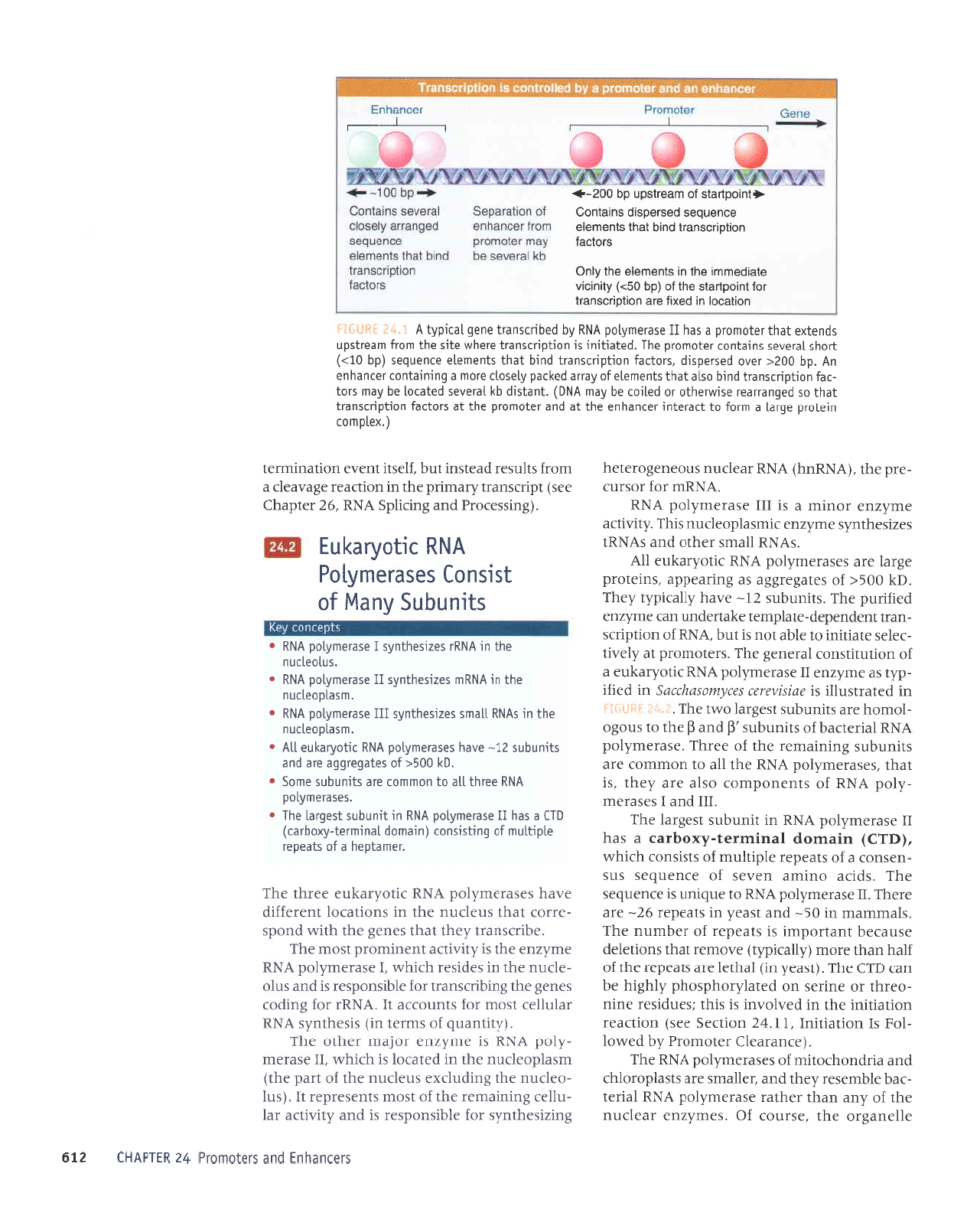
ellauPSJo aqt
'asJnoJ
IO
'sJu^zue
Jeallnu
Jqt
Jo
^ue ueqt
raqler
aseJJu^lod
VNU
Ieuel
-Jeq
elquJssr ^aq]
pup
lellpuls
Jtp slspldorolqJ
pue
PrJpuoqrollrr
Jo
srsprJu^lod
\/Nu
JqJ
'(aruereal3
Jaloruold ,(q
pauol
-IO{
SI
UOI1EI1IUI
,II'V7
UOIlf,JS JJS) UOII)EEJ
UOI]EI]IUI Aql UI
PJ^IOAUI
SI SIq]
:SJNPISAI
JUIU
-oJrql
ro rurrJs
uo
palelLroqdsoqd
.{1q8rq aq
uer
(J)
aq1
'(tseaL
ur)
1eqra1
are
steadar aqt
;o
JIeq
upql aroru
(.{.11errdl1)
a,rourar
tpqt
suorlrlrp
asneJaq
luelrodrur
sr slBadar
Jo
Jeqrunu aqJ
'sleulrueru
ul
0E-
pue
tsear(
ur sleadar
97-
eJe
JreqI
'il
aserarudlod
y1qg
ot anbrun
sr aluanbas
Jr{I
'sprJp
ourure UJAJS
;o
a:uanbas
sns
-uasuo)
e;o sleadar
a1dr11nru
Io
stsrsuoJ
qJIqM
'(qtC)
uleurop
leuruual-AxoqrpJ
e seq
1
aseraruLlod
VNU
ur
trunqns tsaSrel
aq1
'[I
pue
I
sJSeJJu
-r(1od
y-|rlg
Jo
stuJuodruoJ
osle are Laqt
'sr
leql
'seseJJrur(1od
ygu
Jql
IIe
ot uoruuroJ
ere
strunqns Surureruar
er{t
Jo
JJrqJ
'aserau^d1od
VNU
lerrJlreq
Jo
slrunqns
,fl
pue
fl
aqt ot snoSo
-louoq
JJp sllunqns
lsa8rel
o,r.tl J{J'
."'.,
_+
+,:1=-;;
ur
pJlerlsnllr
s aa$aaD)
satfwosa4tsas
ul
pJI]l
-drh
se aru.{zua
1
aseraru.ri.lod
VNU
llodrelna e
Jo
uorlnlrtsuor
leraua8
JqJ
'sJJtoruord
te
.{1anr1
-JJIas
Jtprlrur 01 JIqp
tou
sr
tnq
'VNU
Jo
uondrrls
-ueJl
luepuJdap-ateldruat
e>lpuepun
uer aurLzua
par;rrnd
rqJ'sllunqns
ZI-
a^pr{ .{1errd,{1,{aq1
'q1I
00E<
;o
sate8arSSe
se Surreadde
'surato.rd
a3re1 are saseraur.{1od
vNd
Jrto.dre{nr
IIV
'svNu
Ileus
rrqlo
puP
svNul
sazrsaqlu.{s
aru.dzua
rruseldoapnu
srql'.{.1nrpe
aru,{zua
rourur e
sl
III
aseraurLlod
y1qg
'YNUru
JOJ rosJnJ
-ard
aql'(VXUuq)
vNU
reJpnu
snoauaSorataq
slalueq ul
pue
slalourold
SurnsaqtuLs ro; alqrsuodsJr sr
pue
fula,rpe
re1
-n11ar
SurureuJJ eqt
Jo
tsoru
sluasardar
tI
'(snl
-oJIJnu
aqt
Surpnpxe
snalf,nu aqt
yo
ued
aqr)
ruseldoalrnu
eql ul
pJtplol
sr
qJrqM
'II
aspJaru
-,{1od
ypg
sr aru.,{zua rolBru reqto eql
'(,illruenb
Jo
srurel ur) srsaqluls
VNU
JelnllJl
tsoru
ro; stunoJf,p
tI
'yNUJ.roy
Surpor
sauaS aqt SurqrJJsueJt JoJ alqrsuodsar sr
pup
snlo
-epnu
Jqt ur saprsJJ
qlrqM
'1
asereru,{.1od
VNU
arur{zua
aql sr.dtr.r.rlf,e
luaururord lsolu
eqJ
'JqrJf,supn
daqt
reqr
saua8 aqt
qryn puods
-aJJoJ
leql
snallnu eql ur suorleJol
lueJeJJrp
elpq saspJeu.{1od
VNU
rlto,{rB>lna aJrql JqI
raueldaq e;o sleader
a1d
L11nu
1o
6u
qsrsuor
(ureuop
1eu
Lural-fxoqlec)
0ll
e
seq
11
aserauflod
VNU
ur
lrunqns lsabrel
aql
r
'saserar.ur{1od
vNU
aalql
llP
ol uoururol arP slrunqns ouJo$
r
'01
009<,o
salebar66e aie
puP
slrunqns
zI-
a^pq sasereurtlod
ylx
rqo&e1na
11y
r
'ursPl0o0llnu
oql ur svNU
llpuls
sazrsaqlur\s
111
asereuflod
ylg
r
'ursPlooallnu
aql ur
VNUtU
sazLsaqlufis
11
asetauf1od
ypX
r
'snl00lJnu
oql ur
VNUr
sazrsaqlufs
1
esereufi1od
ypX
r
qrunqns
Aueyrl
1o
lsrsuol
sasPjau^lod
vNu
r!]o&e1n3
'(Surssaro;4
pue
Sunr1dg
vNU
'92
raldeq3
aas)
ldrnsuerl
.,{.rerurrd eql ur uollJear a8e,teap e
ruoJJ sllnseJ
peJlsul
lnq'JIJSll IuJAJ
uortPurruJel
,z
ulldvHl
ztg
('xaldtuor
uLalord a6rel
p
uuoj o]
]telalur
lolueque eql
lp
pue
lalouotd aql
lp
slolreJ uorldursuetl
1eq1
os
pabuelear
asrMiaqlo ro
palrol
aq r\eu
y16)
'luplsrp
ql
lpla^os
palerol
oq feu srol
-lej
uorldulsupll pu[q
oslp
]eql
sluaulola
Jo
feue
palred
r{1eso1r
etou e 6urureluor .lalupquo
uV'dq
002<
rano
pasredsrp'slolleJ
uoLldursuerl
pu!q
lpLll
sluauele
aruanbas
(dq
Of>)
]loqs
lPle^as
surPluol ralouro.lo
aql
'pelerlrut
sr
uorJdulsuell eieqM elrs eql uotJ upallsdn
spualxo
1eq1
ralourotd
p
spq
II
aserau[1od
ypg
fiq peqursuerl
auab
1errdfi1
y
i.'!f
]*il*?j
uollecol ur
pgxrl
are uorloucsueJl
to1
lutodpels
aql
1o
(dq
g9>)
flrurcrn
alerpaulul
orll ur sluourolo
aqt
AuO
sJolcel
uorloucsuejl
pu!q
leql
sluauolo
ocuonbes
pesredslp
suteluoC
<lurodpels
1o
ueetlsdn dq
OOZ->
-_______--------
JOCUeqUf
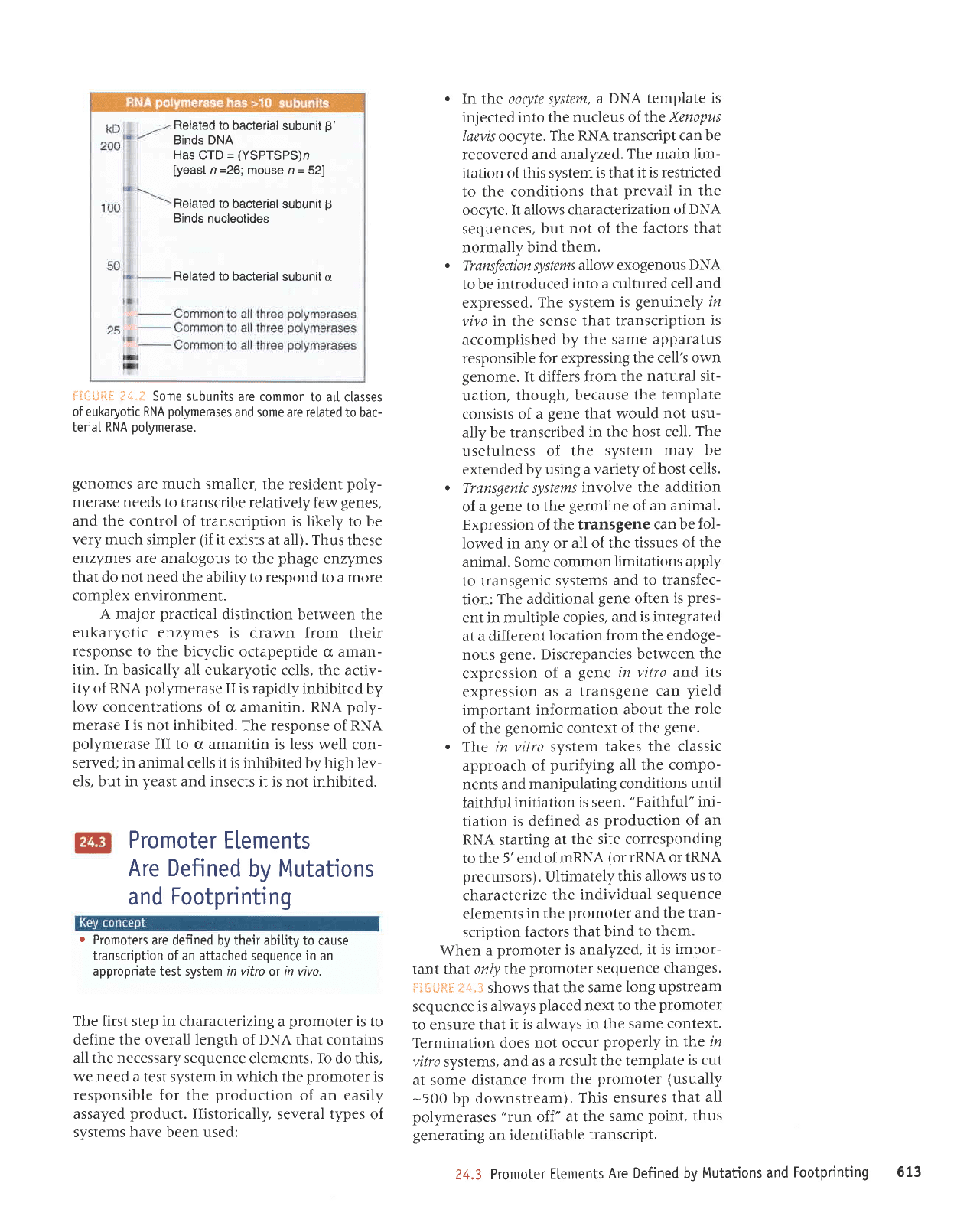
Related to
bacterial subunit
B'
Binds DNA
Has
CTD
=
(YSPTSPS)n
lyeast
n
=26;
mouse
n
=
52]
Related to
bacterial
subunit B
Binds
nucleotides
Related
to bacterial
subunit a
15*#{Cg J4.ii
Some subunits
are common
to atl classes
of eukaryotic RNA
potymerases
and some are related
to bac-
teriaI RNA
potymerase.
genomes
are much smaller,
the resident
poly-
merase needs to transcribe
relatively few
genes,
and
the control of transcription
is likely to be
very much simpler
(if
it
exists at all). Thus
these
enzymes are analogous
to the
phage
enzymes
that do not need
the ability to respond
to a more
complex environment.
A major
practical
distinction between the
eukaryotic
enzymes is drawn from
their
response to the bicyclic
octapeptide d aman-
itin. In
basically all eukaryotic
cells, the activ-
ity of RNA
polymerase
II is rapidly
inhibited by
low concentrations
of
q,
amanitin. RNA
poly-
merase I is not inhibited.
The response
of
RNA
polymerase
III to u amanitin is
less well con-
served;
in
animal cells it is inhibited
by
high lev-
els, but in
yeast
and insects
it is not inhibited.
Promoter
ELements
Are Defined
by
Mutations
and
Footprinting
o
Promoters
are defined by their abitity
to cause
transcription of an attached sequence in an
appropriate test system in vitro
or
in
vivo.
The first step in characterizing
a
promoter
is
to
define the overall length of DNA
that contains
all the necessary sequence
elements. To do this,
we need a test system in which the
promoter
is
responsible for
the
production
of an easily
assayed
product.
Historically,
several
types
of
systems
have
been used:
.
In the llcyte system,
a DNA template
is
injected into
the nucleus of tLre
Xenopus
laevis
oocyte.
The
RNA transcript can be
recovered and
analyzed.
The main lim-
itation of this system
is that
it is restricted
to the conditions
that
prevail
in
the
oocyte. It allows
characterization
of DNA
sequences,
but
not of the factors that
normally bind
them.
.
Transfection systems
allow exogenous
DNA
to be
introduced
into a cultured cell
and
expressed.
The system
is
genuinely ir
vivo in the sense
that transcription
is
accomplished by
the same
apparatus
responsible for expressing
the cell's
own
genome.
It differs
from
the natural sit-
uation,
though. because
the
template
consists of
a
gene
that
would not usu-
ally be transcribed
in the
host cell. The
usefulness
of the system
maY
be
extended by
using a variety
of host cells.
.
Transgenic systems
involve
the addition
of
a
gene
to the
germline
of
an animal.
Expression
of the transgene
can be
fol-
lowed in any or
all of the tissues
of the
animal. Some
common
limitations apply
to transgenic
systems
and to
transfec-
tion:
The additional
gene
often
is
pres-
ent in multiple
copies,
and is integrated
at a
different
location
from the endoge-
nous
gene.
Discrepancies
between
the
expression
of
a
gene
in vitro and
its
expression
as a
transgene
can
yield
important
information
about
the role
of the
genomic
context
of the
gene.
.
The in vitro system
takes
the classic
approach of
purifying
all the compo-
nents and
manipulating
conditions
until
fairhful
initiation
is
seen.
"Faithful"
ini-
tiation is defined
as
production
of
an
RNA starting
at
the site corresponding
to the 5'end
of mRNA
(or
IRNA or IRNA
precursors).
Ultimately
this
allows us
to
characterize
the
individual
sequence
elements
in the
promoter
and
the tran-
scription
factors that
bind
to them.
When
a
promoter is analyzed,
it
is impor-
tant that only t]ne
promoter
sequence
changes.
{jIS#ftil **"}
shows
that
the same
long upstream
sequence is always
placed
next to
the
promoter
to ensure that
it is always
in the
same context.
Termination does
not occur
properly in t}jle tn
vitro
sysrems,
and
as a result
the template
is
cut
at some distance
from the
promoter
(usually
-500
bp downstream).
This ensures
that
all
polymerases
"run
off"
at the
same
point,
thus
generating
an
identifiable
transcript.
24.3
Promoter
Etements
Are
Defined by Mutations
and
Footprinting
613
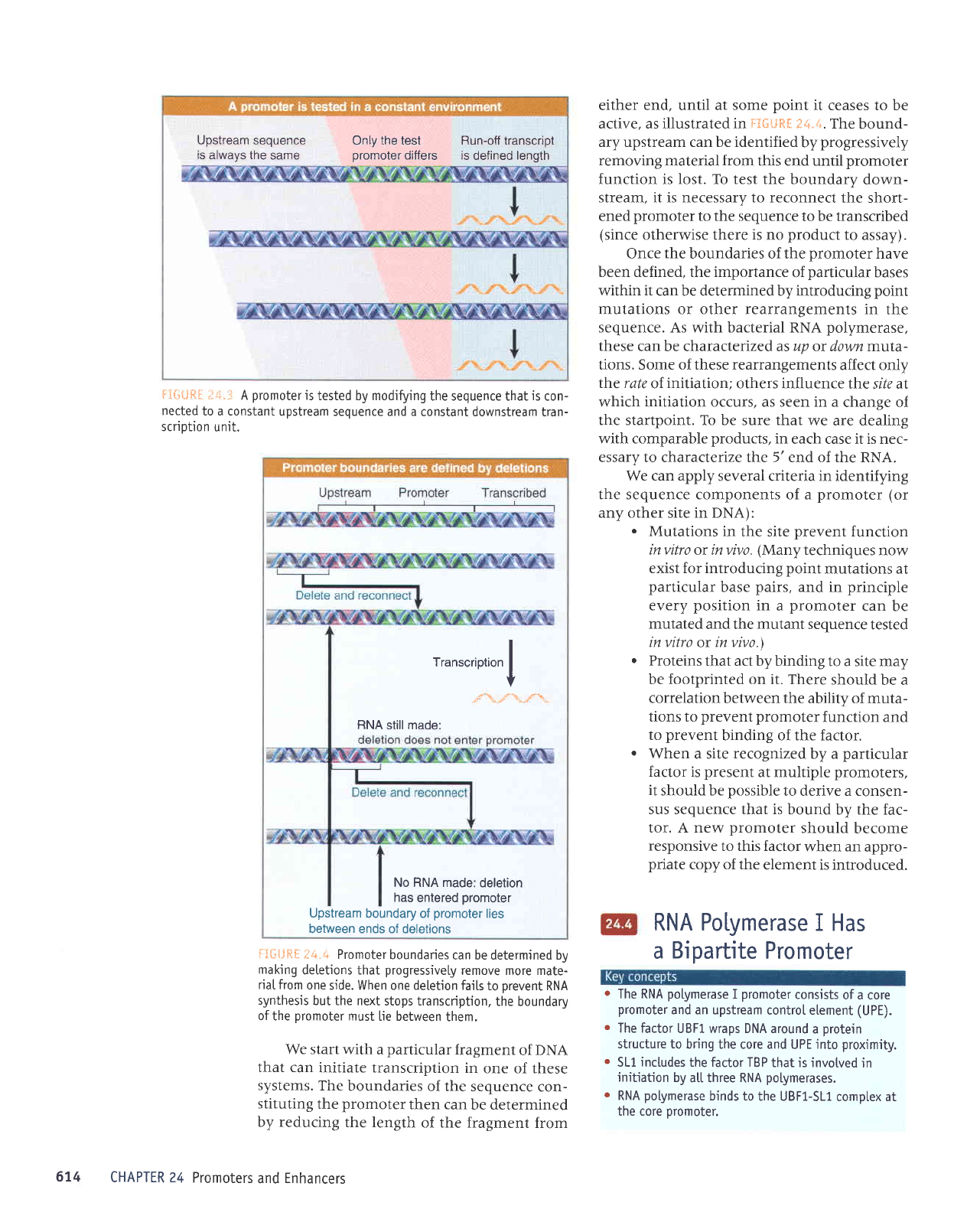
Upstream sequence
Only the test Run-off transcript
is
always the
same
promoter
differs is
defined
length
f ltti*fl I+.-!i
A
promoter
is
tested by modifying
the sequence that
is
con-
nected
to a constant
upstream sequence and a
constant downstream tran-
scriotion
unit.
li*tJith
t+.'t
Promoter
boundaries
can be determined by
making
detetions that
progressively
remove more mate-
rial from
one
side. When one deletion faits
to
prevent
RNA
synthesis
but the next
stops transcription,
the boundary
of
the
promoter
must
lie between
them.
We start
with a
particular
fragment
of
DNA
that can
initiate transcription
in
one of these
systems.
The
boundaries
of the sequence
con-
stituting
the
promoter
then can
be determined
by reducing
the length
of the fragment
from
CHAPTER 24
Promoters
and
Enhancers
either end, until at some
point
it ceases to be
active, as illustrated in
FlStitril Hq.r+.
The
bound-
ary upstream can be identified
by
progressively
removing
material from this end untilpromoter
function is lost. To test the boundary
down-
stream, it is necessary to reconnect
the short-
ened
promoter
to the sequence
to be transcribed
(since
otherwise there
is
no
product
to
assay).
Once
the
boundaries of the
promoter
have
been defined, the importance
of
particular
bases
within
it
can be determined by introducing
point
mutations or other rearrangements in
the
sequence. As with bacterial RNA
polymerase,
these
can be characterized as
up
or down muta-
tions. Some of these rearrangements
affect only
rhe rate
of
initiation;
others influence
ll:re site at
which initiation occurs, as seen in a
change oI
the startpoint. To be sure that
we are dealing
with comparable
products,
in
each case it is nec-
essary to characterize the 5' end of the RNA.
We can apply
several criteria in identifying
the sequence components of a
promoter (or
any other
site
in DNA):
.
Mutations in
the site
prevent
function
invitro or invivo.
(Many
techniques
now
exist for introducing
point
mutations
at
particular
base
pairs,
and in
principle
every
position
in
a
promoter
can
be
mutated
and the
mutant
sequence
tested
in vitro
or
in vivo.)
.
Proteins
that act by binding
to a site may
be footprinted on it. There
should
be a
correlation between the
ability of muta-
tions to
prevent promoter
function
and
to
prevent
binding of the factor.
.
When
a site
recognized
by a
particular
factor
is
present
at multiple
promoters,
it
should be
possible
to derive a consen-
sus sequence that is
bound by the fac-
tor. A new
promoter
should
become
responsive
to this factor
when an
appro-
priate
copy of the
element is introduced.
RNA Polymerase
I Has
a
Bipartite
Promoter
o
The RNA
polymerase
I
promoter
consists
of a core
promoter
and an upstream
controI etement
(UPE).
.
The factor
UBFl wraps DNA around
a
protein
structure to
bring the core and
UPE
into
proximity.
.
511
inctudes
the factor TBP
that is invotved
in
initjatjon
by
a[[ three RNA
potymerases.
o
RNA
potymerase
binds to
the UBF1-SL1
complex at
the core
oromoter.
Transcription
I
s*
\,
es\,
our\-
RNA still made:
No RNA made:
deletion
has
entered
promoter
Upstream
boundary of
promoter
lies
between ends of
deletions
674
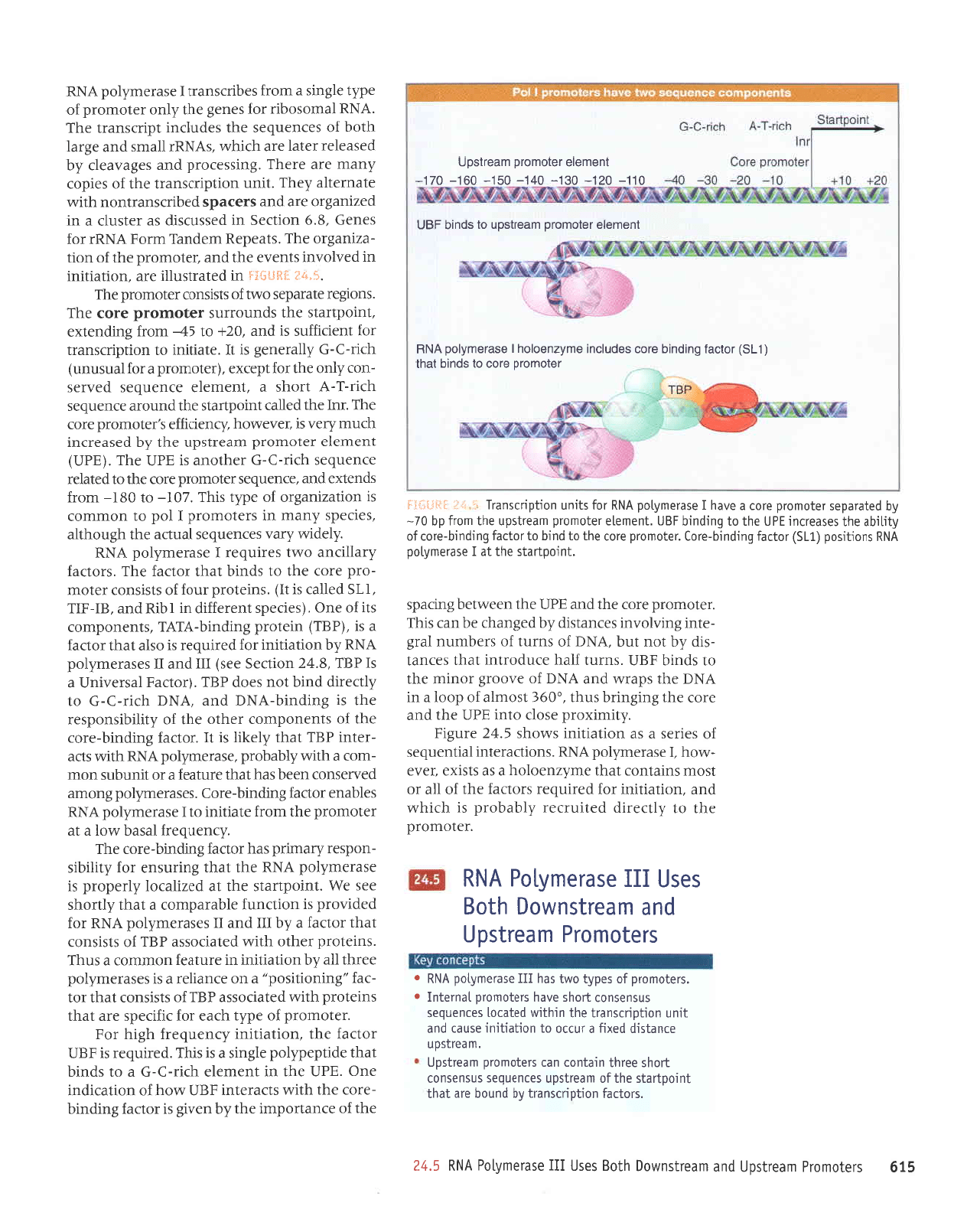
9r9
sralourold rueallsdn pue
uearlsuMoo
qlog
sasn
III
asplaulflod
vNU
g.tz
'slollp1
uorldulsuprl fiq
punoq
olp
lpql
1urod1e1s
eql
Jo
uleollsdn saruanbas snsuasuol
iloqs
aorql ureluol uer sralouord uearlsdl
'ur
PolJs0n
aruelstp
pexq
e lnllo 01 uotlPrlrur esnel
puP
lrun
uorJoulsueJl
aql urqlrM
palplol
seluanDas
snsuasuol
1oqs
enpq slalourold
leulalul
'sralouord
;o
sed[1
o/vq spq
111
eseteur\1od
ypg
pue
uearlsuMo0
qtog
o
a
sasn
III
asPrau^lo6
y115
'ralouo.td
eqt
ot
.d1lra.rrp pallnr)ar
,{lqeqord
sr
qlrqM
pue
'uortertlur
roy
parrnbJJ
sJot)eJ Jql
Jo
IIe
ro
lsotu
surpluor
leql
aurf,zuJoloq
p
sp slsrxe
taAJ
-Moq
'I
aseraur,{.1od
yNU
'suorl)eJJtur
lprluenbJs
Jo
sJrJas
p
sp uorlelllur sMoqs
E'p7
atn?rg
',{.lnuuord
JSop olul
[dn
aqt
pue
eJo) Jrlt Sur8urrq
snql
'"09€
lsotule
Jo
dool
p
ur
VNCI
Jqt sder.,r,r
pue
VNC;o
a,toor8
Jouru Jql
o1 spurq
{gn
'surnl
JIeq
JJnporlur
leql
sJJuel
-sp
^q
tou tnq
'VNq
Jo
surnt
Jo
sraqrunu
pr8
-a1ut
Sutnlo.tur saf,uptsrp dq
paSueqr
aq UEJ srqJ
'raloruord
JroJ aqt
pup
ildn
Jrp uaeMlaq
Srnreds
'1urod1e1s
oql
tP
I
esereulAlod
y1i15
suotltsod
(115)
ropel 6urpuLq-ato1
'talotuotd
elot
oql o]
putq
olloltpr burpurq-ajor;o
AltlLqe eq1 sespollut
ldn
aql o1 6urpurq
lEn
'luauala
relouLo.rd rLLearlsdn
aq1
rLror; dq
91-
Aq
peleredes
relourord
alor
p
oneq
l
eseraurfilod
VNU
lol slrun uoLldursuell
ii
riji
l;glilj.:l
rolor.uoro sJoc ol spurq
leql
(t'lS)
ropel burpurq
eroc sepnlcur eur{zueo;oq
I
esBrau{lod
VNU
luauolo
relouold ueerlsdn ol spulq
lgn
olt- ozt- 0e[- otf-
09t-
09t- 0r.r-
luorrole
Jolourojo ureorlson
eql
Jo
JJupuodur
aqr Lq ueAIS sI
ropey Sutputq
-JJOJ
Jql
qlrM
speJJlul
{gn
lltoq
Jo
uoIlPJIpuI
auo
'adn
aq1 uI
luaualJ
qJIr-)-9
e ol spulq
leqt
apqdad,(1od a13urs
e sI sIqI'parmbar
q
{gn
JolJeJ Jql
'uoltplllur
,{tuanbary
q8tq
rog
'Jetoruord
Jo
adz(r
qJea
JoJ rqtrads JJp
lpql
sureloJd
qlllvr pelerJosse
dgJ
Jo
slsrsuoJ
leql
ro1
-re;
,,3uruor1rsod,,
e uo
JJuprTaJ e st saseraru,{.1od
aeJql
IIe
z(q uor1e41u1 uI eJnleeJ
uoruruoJ P snql
'sureloJd
Jeqto
qtrM
palelJosse
dgI
Jo
slslsuof,
lPql
rolJeJ e
,lq
III
pue
II
saserarudlod
VNU
roJ
paprnord
sr uorlJunJ alqeredruor
e
lpql
^luoqs
aas
JM
'luroduels
Jql
le
pazlerol
,(Fadord
sr
aseraru,{1od
vNu
JrIt
leql
Suunsua
ro; ,hrgqrs
-uodsar
fuerurrd seq
roDel Sutputq-aror aq1
'ATUJnDJJJ
Ieseq
l!\ol
e
le
ratoruord aqt
ruoJJ eleupl ol
I
aseraur,,i.lod
VNU
salqeuJ
rope; Suroutq-aJo)'saseraru.dlod
Suorue
pJ^Jesuo)
uJJq
serl
leql
aJnleJJ
e Jo
Iunqns
uoul
-ruoJ
e
qllM ^lqeqord'ase:arudlody1qg
qtmr
soe
-ralul
dflI
1eq1
L1a4t sI
1I
'JollPJ
Sutputq-aror
aql
Jo
sluJuodruor Jaqlo
Jql
1o
,{lqtqtsuodsar
rrll sr Surpurq-y111(
pue
'vNO
qrlr-f,-J
ol
,(prarrp
pulq
lou
srop
dgl
'(rolred
Iesrellun
e
sI
dgl
'8'tZ
uorpas aas)
Ut
pue
11
saseJaur,{1od
y111g,{q
uolreprur
roJ
perrnber
sr os1e
lpql
rolJpJ
p
sl
'(dSJ)
uletord
Surpurq-y1y1
'stuauodtuor
stl
Jo
auo
'(saoads
luerrJJlp
ul
Iq1g
pue
'gI-dIJ
'Ifs
pellP)
sl
1I)
'sulelord
rnoy
yo
slslsuof, Jelolu
-ord
aror
Jq1 ot spulq
1eql
JopeJ aq1,
'srolJ€I
drelprue o-r,rt sarrnbar
1
aseraruLlod
VNU
d1apr.tr
rfuB,r.
saruanbJs
lpnlrp
aqt
q8noqrp
'sanads
Lueru ut sraloruord
1
1od
o1 uoruuroJ
sr uortezrue8ro
;o
ad,h
slql
'40I-
o]
08I-
ruorJ
spuJxe
pup
'aruanbas
ralourord
aror aqt ol
pat€laJ
aruanbas
qrlr-)-5r rrqloue sl
gdn
rqJ
'(Adn)
tueruele
raloruord
ruBarlsdn
aqt
,{q
peseJJf,ul
qrnru
fua.t sr
ta^Jmor{
'trruaor;;a
s,raloruord aror
eqJ
'rrrl
Jqt
paler
trnoduels
eqt
punoJe
aruanbas
qJIJ-I-V
uoqs
e
'luatuJlJ
atuanbas
pJ^les
-uor
.dpo aql ro;
tdarxa
'(ralouord
e ro;
pnsnun)
qrlr-f,-) .dleraua8 sI
tI
'Jtpll1ul
o1 uorldtnsuert
JoJ
tuJrJrJJns
sr
pue'02+
ol
sV-
ruo.4 Sutpualxa
'lurodlrels
eql spunoJrns
JelouroJd
aror aq1
'suor8ar
aleredas
orr,q
Jo
slslsuo) raloruord
aq1
'$'til
tHf3*i*
uI
pJlerlsnflI
JJP
'uoI]eIlIuI
ur
pJAIoAur
stuJAJ
eqt
pue
:atoruo.td Jqt
Jo
uot]
-ezrue1to
aq1
's1eada5
urepueJ
uJo{
VNUJ
roJ
SJUJD
'8'9
uorlJJS UI
peSSn)SIp
Se
rJlSnlJ E uI
pazrue8ro
ale
pue
s,rareds
pJqIJJSueJluou
qlIM
JlpuJatle
Laql
'1run
uotldtnsuerl
eql
Jo
satdor
Lueru are araql
'Sutssarord
pue
sa8e.teap Lq
pJSpJIer
retel Jre
q)lqM
'svN6t
11eurs
pue:3.re1
qloq
Jo
saruanbes
aqt
sepnpul
ldtttsuerl
aq1
'VNU
leruosoqlJ
JoJ saua8
aql
Lpo raloruord;o
ad,{1 a18urs
e uorJ sJqlJf,sueJl
l
aseraur.dlod
y51g
sralouojd
uPaltsdn
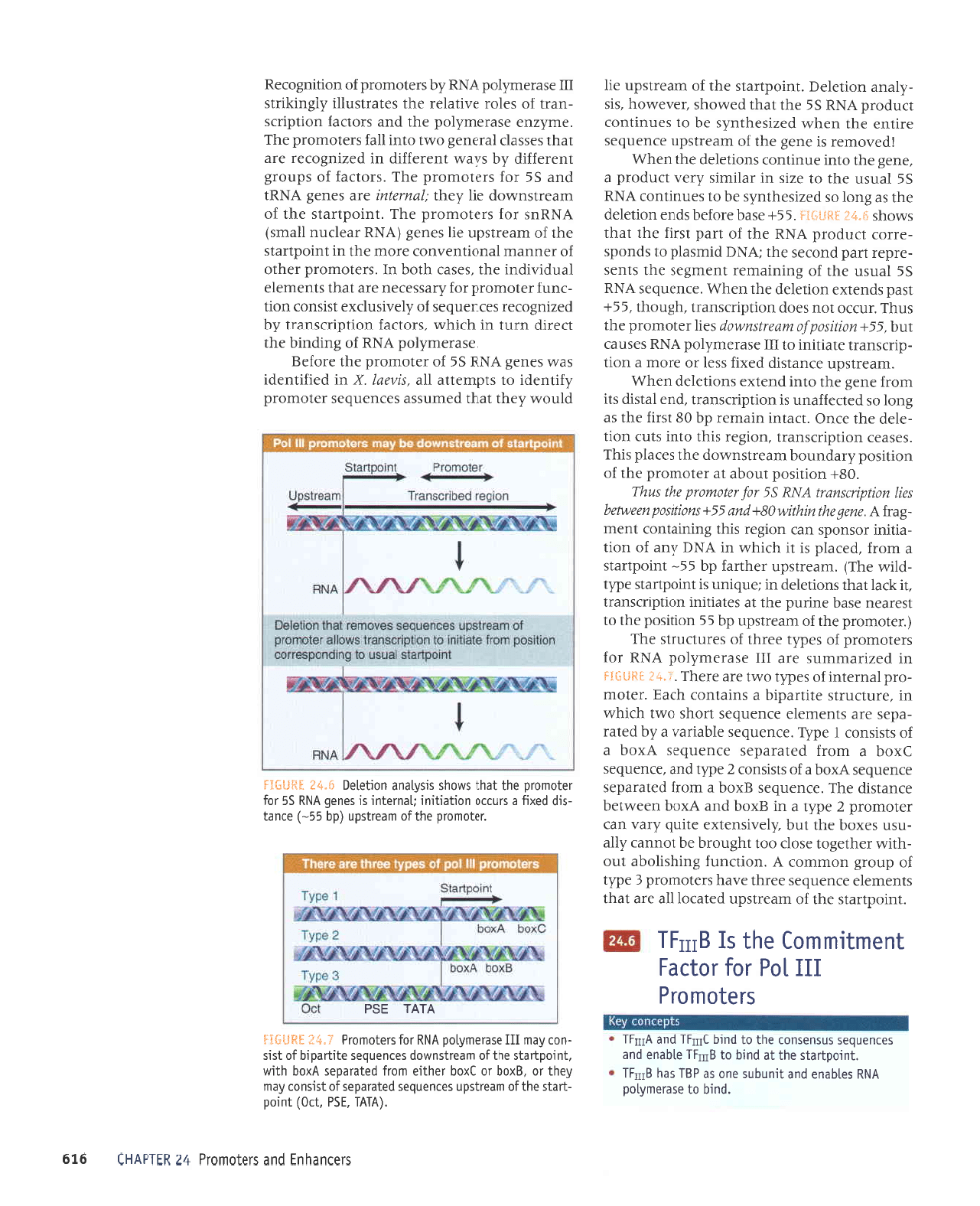
'pulq
ol aselou,{lod
vNU
solqPua
pue
lrunqns
0u0 sP
dgl
spr.l
grri11
'lurodilPts
oql
lp
purq
01
gIIIJt
olqpua
pup
saluanbes
snsuasuol eql
01
putq
1Irr11
pue
yIII3l
sralouoJd
III
lod
roJ rollel
luaulrtul.uol
aql st
glttl1
'turodlrels
Jq1
Jo
rupaJlsdn palerol
IIe
JJe
leql
slualuala aruanbas
JeJql e^eq
sratouord
€
adLl
yo
dnor8 uoruuroJ
V
'uortJunJ
SurqsUoqe
tno
-qryr,t
raqtaSot ssolJ
oo1
lq8norq
aq
louuer
.d1p
-nsn
saxoq Jqt
tnq
Llanrsualxa
atrnb Lren
uet
raloruord
Z
ad,b
e ut
gxoq
pue
VXoq
uJaMlaq
aJuelsrp
aq1
'atuanbes
gxoq
e uorJ
paleredas
aruanbas
yxoq
e
Jo
stsrsuoJ
7
ad&
pue
'aluanbas
)xoq
e ruoJJ
paleJedas
aruanbas
yxoq
e
Jo
stsrsuoJ
I
edrt
'aruanbas
JIqerJeA e Lq
pater
-edas
are stuJruJle
aruanbas
uoqs
omt
q)lqM
ur
'eJnlJnrls
alrlredrq
p
sureluoJ
qleg
'Jeloru
-ord
puratur;o
saddl
oMl JJe aJeqJ
':.t
j
3su*ij
ur
pezrJeruurns
JJe
11
ase-reru,{.1od
y51g
roy
sraloruord;o
sad.{1
JJJqI
Jo
sJJnpnrls JqI
('ralourord
aqt
Io
ueJrtsdn
dq
Eg
uorlrsod
aqt o1
lseJeeu
aseq aur:nd
Jql
le
sJlerlrur uorldulsuerl
'1r
>ppl
teqt
suorlJlJp
ur lanbrun
sr
turoduels
ad.{t
-plIM
rqJ)
'rueartsdn
raqueJ
dq
SS-
turodtrels
p
ruorJ
'pareld
sl
tl
r{Jrr{,lr ul
VNC
Lue;o uorl
-eplur
Josuods
uer uor8a:
srql 3ururcluo)
luJur
-
3e4
y
aua
6 atp ult
fllfrr
0g+
p
ua
S S
+
su o
ut
s o d ua a/yva
q
saq uo4tunsugry
VNA
gg
nl
nlowotd a41 sn41
'08+
uortrsod
tnoqp
tp
ratourord
aqt
Jo
uorlrsod z{.repunoq
rueJJlsuMop
aqt sareld srql
'sespJf,
uotldrrlsue-rl
'uor8ar
slql otur slnJ
uorl
-JIep
Jqt
J)uO
'tJplur
urpruJr
dq
69
rsrry
aqt se
3uo1 os
pJDalJeun
sr
uorldr.rrsuerl
'puJ
Ielsrp
sll
ruory aua8 aqt
olur
puaga
suortalap
uJrIM
'ruea.rlsdn
eJuelsrp
paxrJ
ssel
Jo erour
p
uorl
-dtnsuert
Jtprlrur
01
III
ase]JuLlod
ygg
sJsnef,
tnq'EE+
uotltsodlo
woausufttlp
saq raloruord
aql
snqJ
'rnJto
tou
sJop
uorldr_rrsuerl
'q8noql
,s
S+
lsed
spuaua
uonJlep
aqt
uJqM'aruanbas
yl{g
SS
Iensn
eql
Jo
Sururerua.r
luaru8as
eql stuas
-ardar
ped
puoras
aqt IVNO
ptuseld
o1 spuods
-error
lrnpord
vNu
rql
;o
lred
tsJrJ
aqt
tpql
sMoqs
*'?fi
*H*$I*
'SE+
aspq eroJJq
spur uorlJlep
aql se Euol
os
pJzrsaqluLs
aq o1 sanurtuoJ
17NU
SE
Iensn
Jql
ol ezrs ur
Jelrrurs L:an
unpord
e
'aua8
aql
olur anurtuoJ
suortJlJp
aqt ueqM
ipalorual
sr aua8
Jql
Jo
ueJrlsdn
aruanbas
aJllue
aql ueql{ pazrsaqlu[s
Jq ot sanur]uoJ
trnpord
vNU SS
eql
teqt
peMoqs
te^emoq
'srs
-,{pue
uorlalee
'turoduels
er{t
Jo
upeJlsdn
arT
sraluequl
puP
sralouord
'(vrvr
'lsa
'pg)
lurod
-1.tp$
aql
Jo
ueerlsdn saruenbas
paleredas
;o
lsrsuor
feu
faql ro
'EXoq
ro
lxoq
.laqlra uor;
pale.redas
VXoq
qlm
'1urod1e1s
eql
Jo
upa.llsuMop saruanbas alrledrq
;o
lsrs
-uor
feu
111
aserauf1od
VNU
roJ s.ralouord
t'?t
$Hfi*g:*
VIVI fsd
'raloLuord
aq11o uearlsdn
(dq
99-)
eruel
-srp
poxrl
e srnllo uorlerlrul
ileuralur
sr sauab
VNU
Sg
roJ
raloLuord
oql
lpql
srvroqs srsfleue uoqala6
*'t?
lsfl*i*
plno,lr
Laqr
reqr
parunssp
seJuenbas raloruo.rd
,(Jrtuapr
ot stdrualle
IIe
'swaol'x
ur
perJrluJpr
se.,vr saua3
VNU SS
;o
ratoruord eql JJoJeg
'ase:aru.d1od
VNU
Jo
Surpurq
aql
lf,JJIp
uJnl ur
qJrr{,lr
'sJolleJ
uorldrnsue;l [q
pazuSorar
sef,uJnbJs
;o
Llarrrsnpxa
lsrsuof,
uorl
-)unJ
Jelouord ro; Lressarau
are
lpql
sluatuele
Ipnprlrpur
Jqt
'sase)
qtoq
uI
'sraloruord
raqlo
Io
Jeuueu
Ipuorlueluof,
eJour eql ut
luroduels
eql
Jo
rueallsdn
at1 saua8
(y111g
reJIJnu
lprus)
VNUUs
roJ srelouord aq1
'tulodlJets
eql
Jo
rupJJlsumop
srl
,,(aql
:lvuhlut
are saua8
yggl
pup
SE
roJ
sretouord aq1
'srol)pJ
;o
sdnor8
tuaJeJlrp
,{q
s,{e,u
tuJJJJJrp
ur
pazruSorar
eJp
teqt
sasselJ praua8
o&rl olur
1e;
sratourord
aq1
'aru[zua
aseraruLlod aq] pue
srolJpJ uorldrns
-upJl
Jo
sJIoJ alrtelar
Jr{l seterlsnp Lpuqrrls
1a
aseraru.{1od
y51g,{q
sraloruord
;o
uopFSoJJU
rz
ulldvHl
919
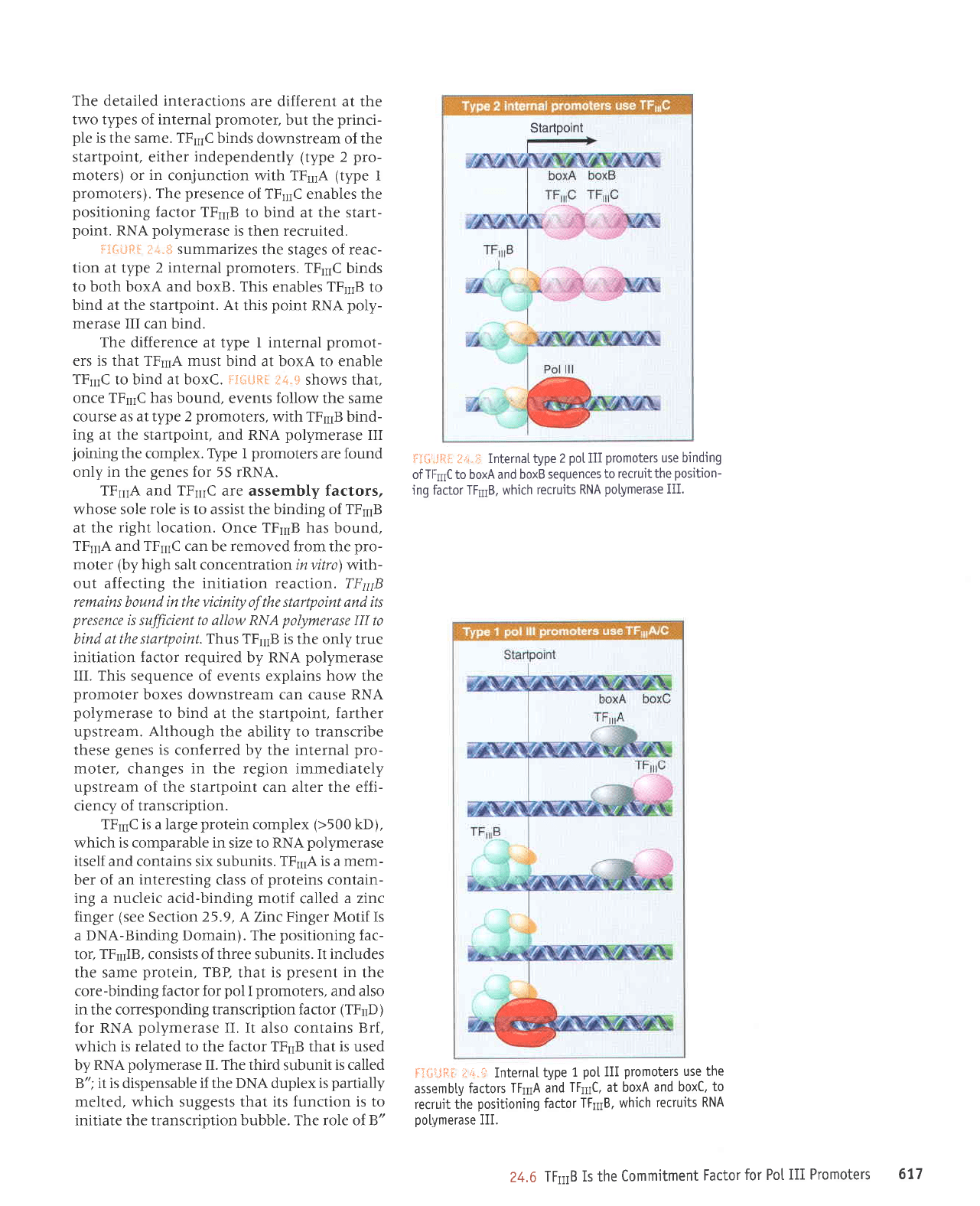
The detailed interactions
are
different at the
two types of internal
promoter,
but
the
princi-
ple
is the same. TFnIC binds
downstream of the
startpoint, either
independently (type
2
pro-
moters)
or
in
conjunction with TFrrrA
(type
I
promoters).
The
presence
of
TFgC
enables the
positioning
factor TFnIB
to bind at the start-
point.
RNA
polymerase
is then recruited.
ft{-iiJ{tf
Ii'Fi summarizes
the stages of reac-
tion at type 2 internal
promoters.
TFnIC binds
to both boxA and boxB. This enables TFnIB
to
bind at the startpoint. At
this
point
RNA
poly-
merase III
can bind.
The difference at type I internal
promot-
ers is that TFgA must
bind at boxA to enable
TF111C
to bind at boxC. ilI{ri"iRf" i+"$
shows that,
once TFnIC has bound,
events follow the same
course as at type 2
promoters,
with TFnIB bind-
ing
at the startpoint, and RNA
polymerase
III
joining
the complex. T\,pe I
promoters
are
found
only
in
the
genes
for
5S rRNA.
TF111A and TFl1yC
are assembly factors,
whose sole
role is
to assist the binding of TF11B
at the right
location.
Once TF111B has
bound,
TFnIA and TFnIC can
be
removed
from the
pro-
moter
(by
high
salt concentrationinvitro) with-
out affecting the initiation
reaction. TFpB
remains bound in the vicinity of the startpoint and its
presence
is sufficient to allow RNA
polymerase
III
to
bind at
the startpoint. Thus TFynB
is the only true
initiation factor required by RNA
polymerase
IIL This sequence of events
explains
how
the
promoter
boxes downstream can cause RNA
polymerase
to bind
at the startpoint, farther
upstream. Although the ability to transcribe
these
genes
is conferred by the internal
pro-
moter,
changes
in
the
region
immediately
upstream of the startpoint can alter the effi-
ciency of transcription.
TF6C is a large
protein
complex
(>500
kD),
which
is comparable in
size to
RNA
polymerase
itself
and contains six subunits. TFnIA is a
mem-
ber of an interesting class of
proteins
contain-
ing a nucleic acid-binding motif
called
a zinc
finger
(see
Section
25.9,
A Zinc Finger Motif Is
a DNA-Binding Domain). The
positioning
fac-
tor, TFrrrlB, consists of three subunits.
It includes
the same
protein,
TBP,
that is
present
in
the
core-binding factor for
pol
I
promoters,
and also
in
the corresponding
transcription factor
(TFnD)
for RNA
polymerase
II. It also contains
Brf,
which
is related to the factor TF1B that is used
by
RNA
polymerase
II. The third
subunit
is called
B"; it is dispensable if the DNA duplex is
partially
melted, which suggests
that its function is to
initiate the transcrintion bubble. The role of B"
Startpoint
ilIfir"Jf{i:
il:i.ii
InternaI type
2
pot
III
promoters
use binding
of TllnC to boxA and boxB
sequences
to
recruit the
position-
ing factor TFn1B, which
recruits
RNA
polymerase
IIL
ffiliJfii
;lr;.{i Internal
type
1
pot
III
promoters
use the
assl'mbty
factors
TFrrrA and
TFn1C, at boxA
and boxC.
to
recrujt the
positioning
factor
TFn1B. which
recruits
RNA
po['ymerase
IIL
24.6
IF1B
Is the
Commitment
Factor
for Po[
III Promoters
677
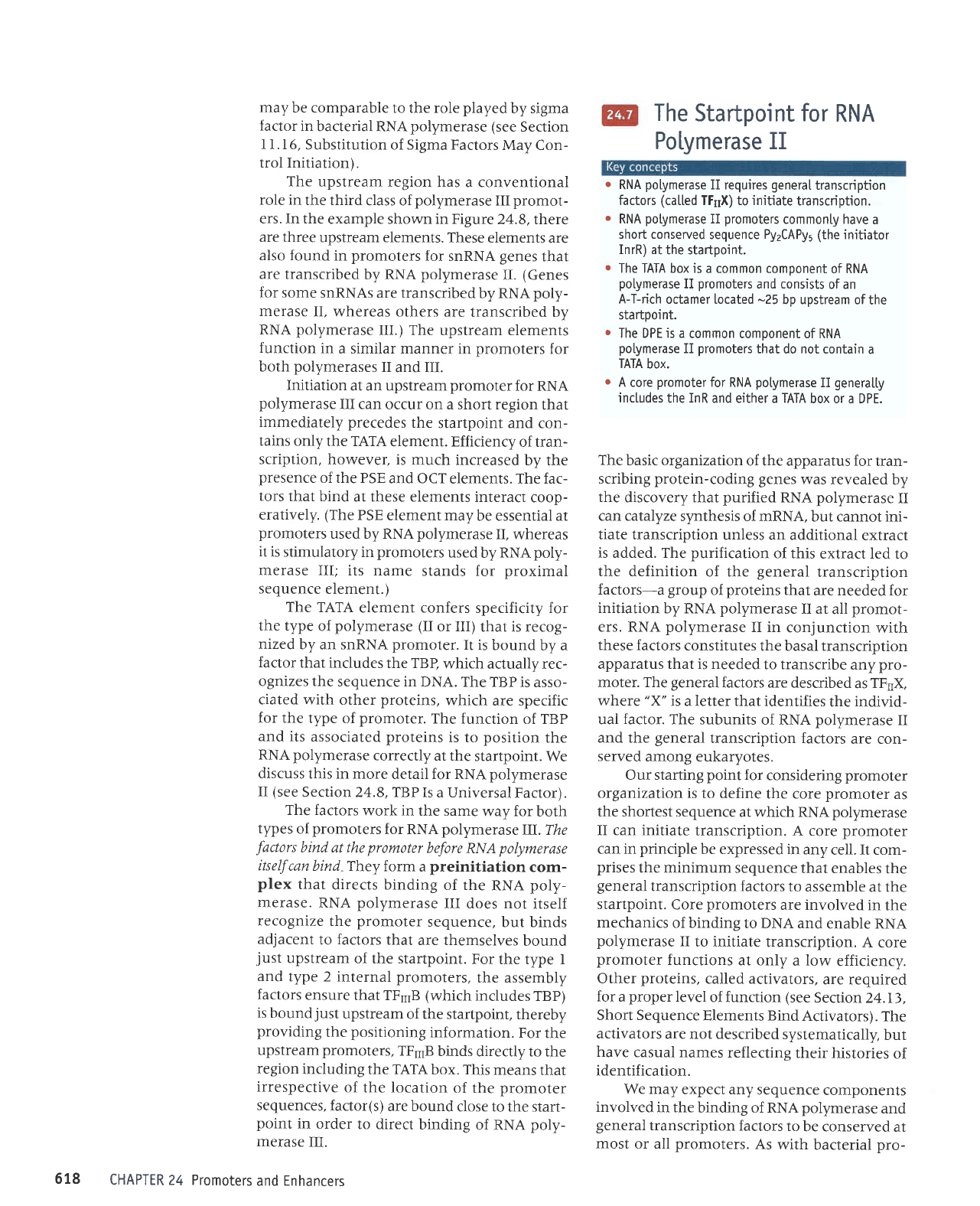
may
be comparable
to the role
played
by sigma
factor
in
bacterial RNA
polymerase (see
Section
I 1.I6,
Substitution of Sigma Factors
May Con-
trol Initiation).
The
upstream region has
a conventional
role in
the third
class of
polymerase
III
promot-
ers. In the
example shown in Figure
24.8,there
are three
upstream elements.
These elements
are
also found
in
promoters
{or snRNA
genes
that
are transcribed
by RNA
polymerase
II.
(Genes
for some
snRNAs are transcribed
by RNA
poly-
merase
II, whereas
others are
transcribed by
RNA polymerase
III.) The
upstream elements
function
in
a similar manner
in
promoters
for
both
polymerases
II
and III.
Initiation
at an upstream
promoter
for RNA
polymerase
III can
occur on a short region
that
immediately precedes
the
startpoint and
con-
tains only
the TATA
element. Efficiency
of tran-
scription,
however, is
much increased
by the
presence
of the PSE
and OCT
elements. The fac-
tors
that bind
at these elements
interact
coop-
eratively.
(The
PSE
element may
be essential at
promoters
used by RNA
polymerase
II,
whereas
it
is stimulatory
in
promoters
used
by
RNA
poly-
merase III;
its name
stands for
proximal
sequence
element.)
The
TATA
element confers
specificity for
the type
of
polymerase
(II
or III)
that is recog-
nized
by an snRNA
promoter.
It
is bound
by a
factor
that includes
the TBP,
which
actually rec-
ognizes the
sequence in
DNA. The TBP
is asso-
ciated with
other
proteins,
which are specific
for the
type of
promoter.
The function
of TBP
and
its associated proteins
is to
position
the
RNA
polymerase
correctly
at the
startpoint.
We
discuss
this in more
detail for RNA
polymerase
II
(see
Section
24.8,T8P
Is a Universal
Factor).
The factors
work in
the same
way for
both
types
of
promoters
for RNA
polymerase
III. The
factors
bind at the
promoter
before
RNA
polymerase
itself
can bind They
form
a
preinitiation
com-
plex
that
directs binding
of the
RNA
poly-
merase.
RNA
polymerase
III does not
itself
recognize
the
promoter
sequence,
but binds
adjacent
to
factors
that
are themselves
bound
just
upstream
of the startpoint.
For
the type I
ill#::
i
[l"^T#,ffi
Hi,::il,'*:
Ji: : T,lil
is bound
just
upstream
of the startpoint,
thereby
providing
the
positioning
information.
For
the
upstream
promoters,
TFnyB
binds
directly to the
region
including
the TATA
box. This
means
that
irrespective
of
the location
of the
promoter
sequences,
factor(s)
are bound
close to
the start-
poinr
in order
ro direct
binding
of RNA
poly-
merase III.
CHAPTER 24 Promoters
and
Enhancers
The
Startpoint for
RNA
Polymerase II
o
RNA
potymerase
II requires
generaI
transcription
factors
(ca[[ed
TFsX) to init'iate
transcription.
r
RNA
potymerase
II
promoters
commonty have
a
short conserved
sequence
Py2CAPy5 (the
initiator
InrR) at
the startpoint.
r
The
TATA box is a common component
of RNA
potymerase
II
promoters
and consists
of an
A-T-rich
octamer located
-25
bp upstream of
the
startpoint.
r
The DPE is a
common component of RNA
potymerase
II
promoters
that do not contain
a
TATA
box.
o
A core
promoter
for
RNA
potymerase
II
generalty
includes
the
InR
and either a TATA
box or a DPE.
The basic organization
of the apparatus for
tran-
scribing
protein-coding genes
was revealed
by
the
discovery that
purified
RNA
polymerase
II
can catalyze
synthesis of mRNA,
but cannot ini-
tiate transcription
unless an additional
extract
is added. The
purification
of this
extract led
to
the definition
of the
general
transcription
factors-a
group
of
proteins
that
are needed
for
initiation
by RNA
polymerase
II at
all
promot-
ers. RNA
polymerase
II in
conjunction
with
these factors
constitutes
the basal transcription
apparatus that is needed
to transcribe
any
pro-
moter. The
general
factors are
described
as
TFnX,
where
"X"
is aletter that identifies
the
individ-
ual
factor.
The subunits
of RNA
polymerase
II
and the
general
transcription
factors
are con-
served
among eukaryotes.
Our starting
point
for
considering
promoter
organization
is to define
the core
promoter
as
the shortest sequence
at
which
RNA
polymerase
II can initiate
transcdption.
A core
promoter
can in
principle
be expressed
in any
cell. It com-
prises
the minimum
sequence that
enables
the
general
transcription factors
to
assemble
at the
startpoint.
Core
promoters
are involved
in
the
mechanics
of binding
to DNA and
enable
RNA
polymerase
II
to initiate
transcription.
A
core
promoter
functions
at only
a low
efficiency.
Other
proteins,
called activators,
are required
for
a
proper
level
of function
(see
Section
24.13,
Short Sequence
Elements Bind
Activators).
The
activators
are not described
systematically,
but
have
casual names
reflecting
their
histories
of
identification.
We may
expect any
sequence
components
involved
in the
binding of RNA
polymerase
and
general
transcription
factors
to
be conserved
at
most
or all
promoters.
As
with
bacterial
pro-
618
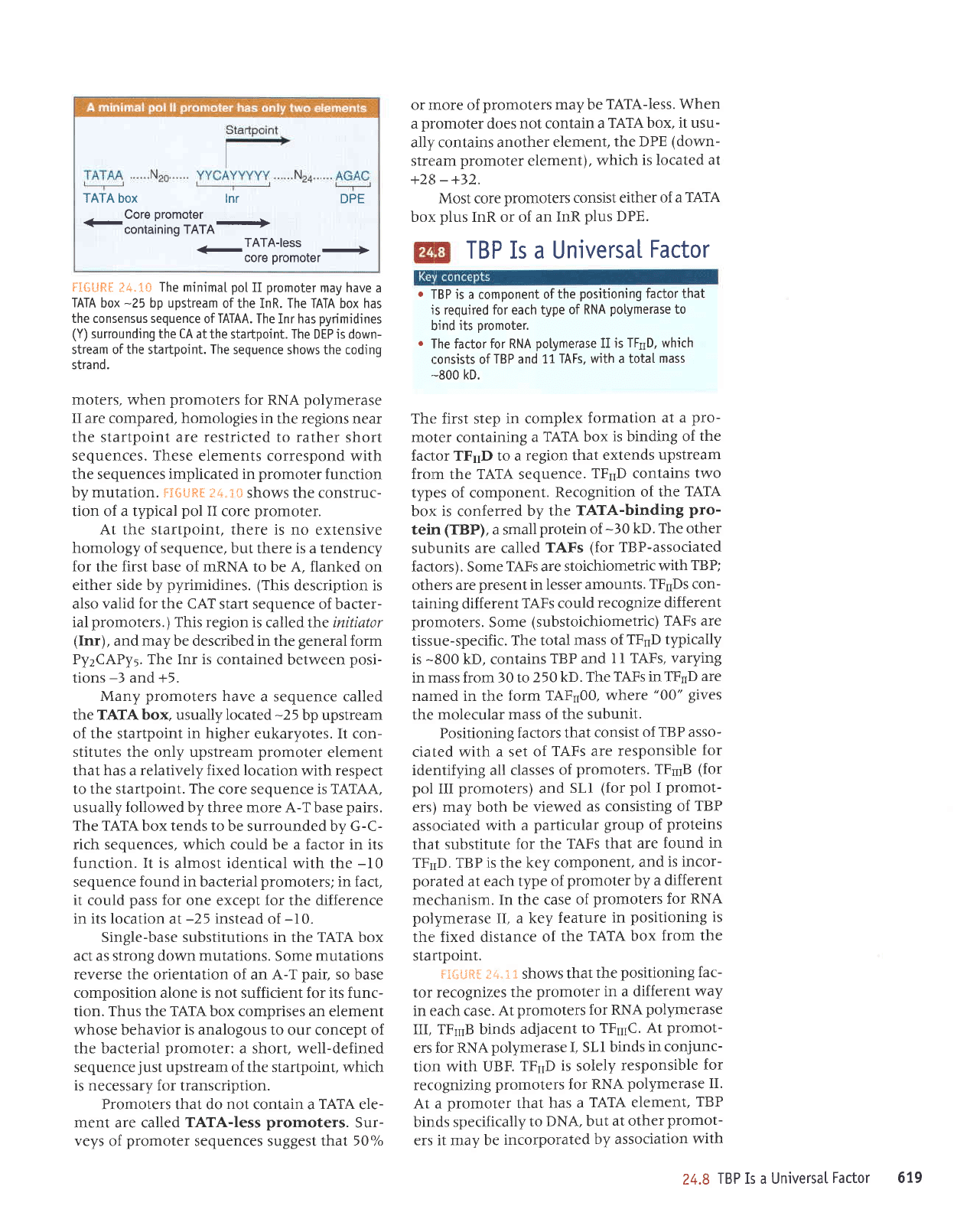
TATA box Inr
DPE
- Core oromoter
-contarnrno
-tnTn-
-TATA-less
core Dromoler
FIfiURf I4"t*
The minimaI
pol
II
promoter
may have a
TATA
box
-25
bp upstream
ofthe InR. The TATA box has
the consensus sequence
of
TATAA.
The Inr has
pyrimidines
(Y)
surrounding the CA at
the startpoint. The DEP is down-
stream of the startpoint. The
sequence shows the coding
strand.
moters, when
promoters
for RNA
polymerase
II are compared, homologies in
the regions near
the startpoint are
restricted
to rather
short
sequences. These elements
conespond with
the sequences implicated in
promoter
function
by mutation. FISTJRE I4":*
shows the construc-
tion of a typical
pol
II
core
promoter.
At the startpoint, there
is no extensive
homology of sequence,
but there is a tendency
for
the first base of mRNA to
be
A, flanked
on
either side by
pyrimidines.
(This
description is
also valid
for
the CAT start sequence
of bacter-
ial
promoters.
)
This region is
called the initiator
(Inr),
and
may
be described in the
general
form
Py2CAPy5. The Inr is
contained between
posi-
tions
-3
and +5.
Many
promoters
have
a sequence called
the TATA box, usually lo cared
-25
bp upstream
of the startpoint
in higher
eukaryotes. It con-
stitutes the only upstream
promoter
element
that
has
a
relatively fixed location
with respect
to the startpoint.
The
core sequence is TAIAA,
usually
followed
by three more A-T base
pairs.
The TATA box tends
to be surrounded by G-C-
rich sequences, which could be a factor in its
function.
It is
almost identical with the
-10
sequence
found in bacterial
promoters;
in fact,
it
could
pass
for
one except lor the difference
in its location at
-25
instead of
-10.
Single-base substitutions in the TATA box
act as strong
down mutations.
Some
mutations
reverse the orientation of an A-T
pair,
so base
composition alone is not sufficient for its func-
tion. Thus the TAIA box comprises an element
whose behavior
is analogous
to our concept of
the bacterial
promoter:
a short, well-defined
sequence
just
upstream of the startpoint, which
is necessary for transcription.
Promoters that do
not
contain a
TATA
ele-
ment are called
TATA-less
promoters.
Sur-
veys
of
promoter
sequences suggest Ihat
50o/"
or rnore of
promoters
may be
TATA-less. When
a
promoter
does not contain
a TAIAbox,
it usu-
ally'contains another
element,
the DPE
(down-
str€ram
promoter
element),
which
is located at
+28
-+32.
Most
core
promoters consist either
of a TATA
bor:
plus
InR or of an
InR
plus
DPE.
TBP Is a Universal
Factor
o
TBP is a
component
of
the
positioning
factor that
is required for each type
of RNA
potymerase
to
bind
its
Dromoter.
o
The factor
for
RNA
potymerase
II is
TFnD, which
consists ofTBP
and 11
TAFs, with a total
mass
.-800
kD.
The first step in complex
formation
at a
pro-
moter containing
a
TATA box
is binding of
the
factor TFID to a
region that
extends
upstream
from the TATA sequence.
TFnD contains
two
types of component.
Recognition
of the
TAIA
bo>r is conferred
by the
TATA-binding
pro-
tein
(TBP),
a small
protein
of
-30
kD. The other
sub,units
are called
TAFs
(for
TBP-associated
fact.ors). Some
TA-Fs are stoichiometric
with
TBP;
others are
present
in lesser
amounts.
TFnDs con-
taining different
TAFs
could
recognize different
promoters.
Some
(substoichiometric) TAFs
are
tissue-specific.
The total
mass
of TF1D
typically
is
-800
kD, contains
TBP and
I I TAFs, varying
in rnass from 30 rc
2r0
kD. The
TAFs in TFnD
are
narned in the
form TAF1O0,
where
"00" gives
the molecular
mass of
the subunit.
Positioning
factors that
consist
of TBP asso-
ciated with
a set of
TAFs are
responsible
for
identifying all classes
of
promoters. TFnIB
(for
pol
III
promoters) and
SLI
(for pol
I
promot-
ers) may both be
viewed
as consisting
of
TBP
associated
with a
particular
group
of
proteins
that substitute
for the
TAFs that
are found
in
TF1D. TBP is the
key component,
and
is incor-
porated
at
each type
of
promoter
by
a different
mechanism.
In the case
of
promoters for RNA
polymerase
II,
a
key
feature
in
positioning is
the fixed distance
of
the TATA
box
from the
sta
rtpoint.
FlSilRf,
fi4.1:.
shows
that
the
positioning fac-
tor recognizes
the
promoter in a different
way
in each case.
At
promoters
for RNA
polymerase
III, TFrrB binds
adjacent
to
TFn1C.
At
promot-
ers for RNA
polymerase I, SLI
binds
in conjunc-
tion with UBF.
TF1D is solely
responsible
for
recognizing
promoters for
RNA
polymerase II'
At a
promoter
that
has a
TAIA element,
TBP
binLds
specifically
to
DNA, but
at other
promot-
ers it may be
incorporated
by association
with
24.8
TBP Is a Universal
Factor 679
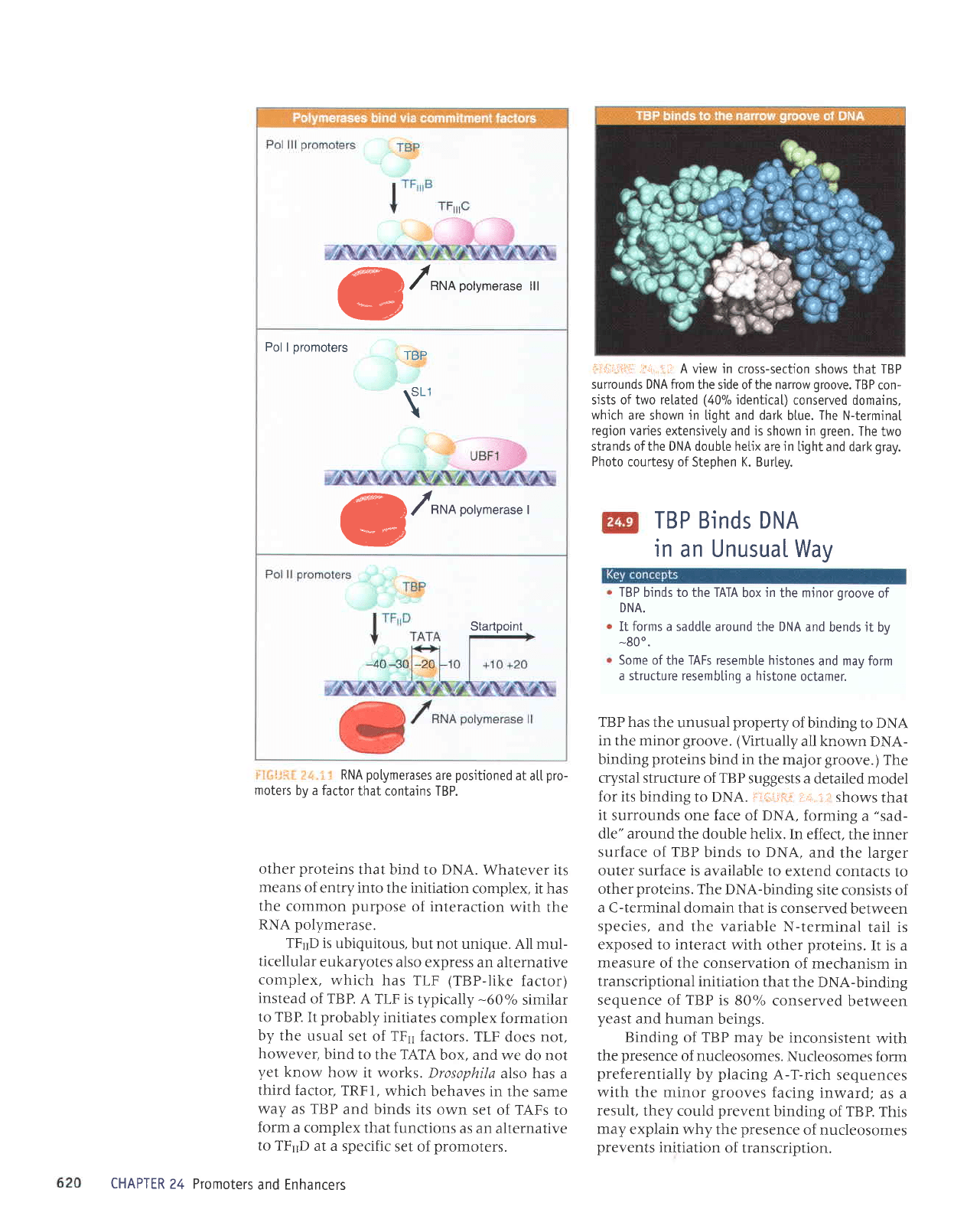
other
proteins
that bind to DNA.
Whatever irs
means
of entry into
the
initiation
complex, it has
the common purpose
of interaction
with the
RNA
polymerase.
TFnD
is ubiquitous,
but not
unique. All
mul-
ticellular
eukaryotes
also
express an
alternative
complex,
which has TLF (TBP-like
factor)
instead
of TBP. A
TLF is typically
-60%
similar
to TBP.
It
probably
initiates
complex
formation
by the
usual set
of TF11 factors.
TLF
does not,
however,
bind to
the TATA
box, and
we do not
yet
know how
it
works.
Drosophila
also has
a
third factor,
TRFI,
which
behaves in
the same
way
as TBP
and binds its
own set
of TAFs ro
form
a complex
that functions
as an
alternative
to TF1ID
at i
specific set
of
promoters.
CHAPTER
24 Promoters
and Enhancers
rl.r;!
jiii:
i:.:l
I
il A view in
cross-sectjon shows
that
TBP
surrounds DNA from
the side ofthe
nanow
groove.
TBP
con-
sists of two related
(40%
identicat)
conserved domains,
which
are shown
jn
tight and dark
btue.
The
N-terminal.
region varies
extensivety and is shown in
green.
The
two
strands ofthe DNA doubte hetjx
are
in
light and dark
gray.
Photo
courtesy of
Stephen
K. Burtey.
TBP Binds DNA
in
an UnusuaI Way
TBP
binds to the TATA
box
in
the minor
qroove
of
DNA.
It forms a sadd[e
around the
DNA
and
bends it bv
-800.
Some of
the
TAFs resembte
histones
and may form
a structure resemblinq
a
histone
octamer.
TBP has the
unusual
property
of
binding
to
DNA
in the minor
groove. (Virtually
all known
DNA-
binding
proteins
bind in the major
groove.)
The
crystal structure of TBP
suggests a
detailed model
for its
binding to DNA.
i:li.rl.j*i:
,t",
"r
ii
shows
that
it
surrounds one face
of
DNA,
forming
a
"sad-
dle" around the double helix.
In effect,
the inner
surface
of TBP binds to DNA,
and
the larger
outer surface is
available to extend
contacts
to
other
proteins.
The DNA-binding
site
consists
of
a C-terminal
domain that is conserved
between
species, and
the variable
N-terminal
tail is
exposed to interact
with
other
proteins.
It is a
measure
of the conservation
of mechanism
in
transcriptional
initiation
that the
DNA-binding
sequence
of TBP is 80%
conserved
between
yeast
and human
beings.
Binding
of TBP may
be inconsistent
with
the
presence
of nucleosomes.
Nucleosomes fonn
preferentially
by
placing
A-T-rich
sequences
with the
minor
grooves
facing inward;
as a
result.
they could
prevent
binding
of TBP.
This
may
explain why
the
presence
of nucleosomes
prevents
initiation
oI transcriprion.
Q}
/^*oporymerase
rl
Pol
I
promoters
.
IBP
15L1
\
\
C
/^*oporymerase
I
Startpoint
,r
:'
'
RNA
polymerases
are
positioned
at
atl
pro-
moters
by a factor
that contains
TBP.
